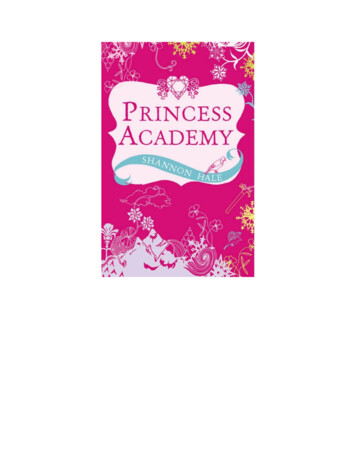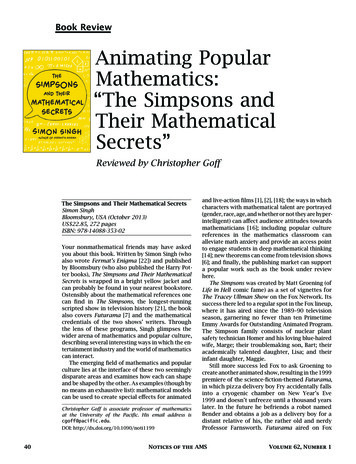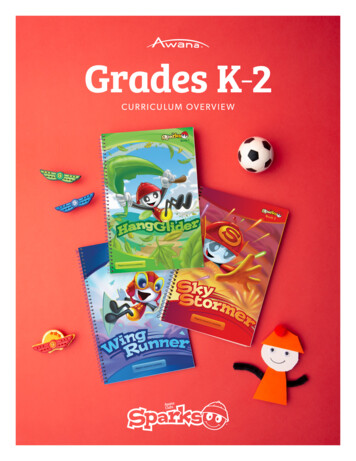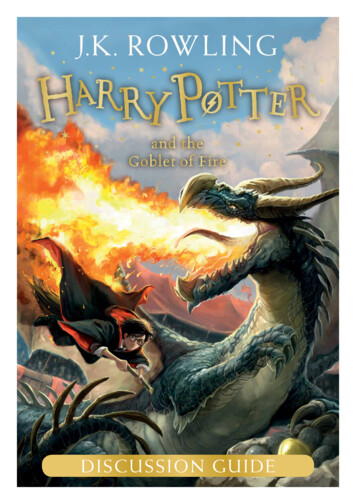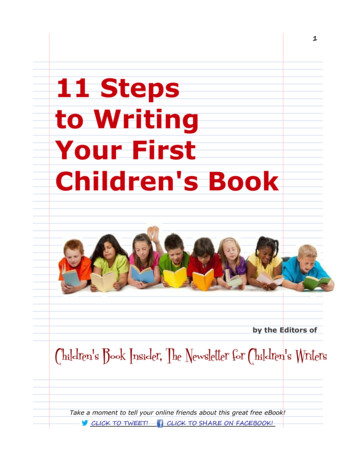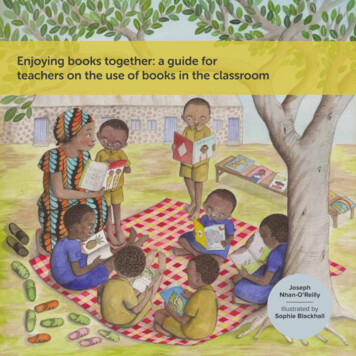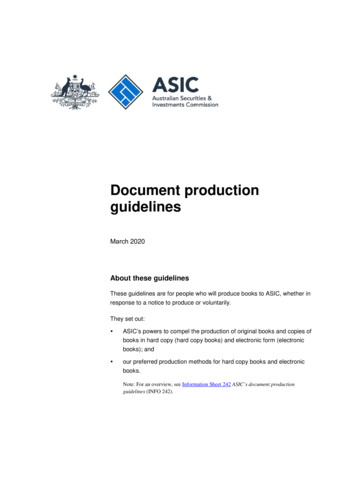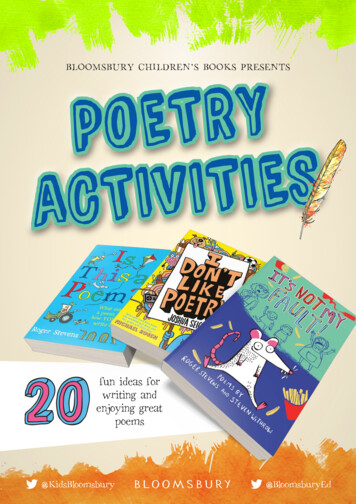
Transcription
BLOOMSBURY CHILDREN’S BOOKS PRESENTSYRTPOESEITIVITACfun ideas forwriting andenjoying greatpoems@KidsBloomsbury@BloomsburyEd
Write a haikuRead: ‘Haiku’ on p42 in It’s Not My Fault! and‘Funny Haiku’ and ‘Dog Haiku’ on p13 in I Don’t Like PoetryThe haiku is one of the simplest forms of poem there is. It comes from Japan and has only three lines—the first with five syllables, the middle with seven syllables and the third with five syllables again.But that doesn’t mean a haiku is easy to write! It has to convey something in just a few words, soevery syllable counts. Take a look at these poems to see how it’s done.Now try to write your own. It can be about anything you like, though many haiku’s havebeen about the seasons or weather, so you could use those as starting points.Remember to double-check you have the right number of syllables!Complete the limerickLimericks are short poems of five lines—of which the first, second and fifth rhyme with each other,and the third and fourth lines too. They have a distinctive rhythm and sound great whenread out loud. Here’s a well-known example by Edward Lear.There was an old man in a treeWho was horribly bored by a beeWhen they said ‘Does it buzz?’He replied ‘Yes it does,’‘It’s a regular brute of a bee!’As you can see, limericks are often witty or full of nonsense, and they are fun and quick to write.Try one of your own! Here’s a first line to get you started.There once was a young boy called Pete
Memorise a poemFor hundreds of years, poems were designed to be read out loud rather than written down.That tradition started to change when books were first printed, but live performance poetryevents are still very popular today.Can you memorise a poem so you can recite it to family or friends? They’re sure to be impressed.Pick some poems from It’s Not My Fault!, I Don’t Like Poetry orIs This a Poem? and see how quickly you can remember them.Choose a short poem to start with and move on to longer ones!Write using onomatopoeiaRead: Verse 4 of ‘I Don’t Like Poetry’ on p4 inI Don’t Like PoetryOnomatopoeia: it’s a tricky word to spell but an easy one to define! It is a word that sounds likethe thing it is describing—like ‘cuckoo,’ ‘oink’ or ‘whack’. They are excellent words to use in poetrybecause they are very descriptive and sound good when they are read aloud.Here are a dozen more onomatopoeic words. Choose three of them and see if youcan incorporate them into a short poem of your lashRoarZoomTeam up on a poemWriting a poem in collaboration with friends can produce some really interesting results.Get a group of you together and agree on a subject and title for a poem. Thenwrite a line of the poem each before passing it on to the next person. Either setyourselves a certain number of lines to complete or just finish the poem when it feels right.
Try a tricky tongue twisterRead: ‘Short Sharp Poem’ and ‘Otter Letters’ on p24 inI Don’t Like PoetryTongue twisters are really fun poems to write. They are very short verses that arefull of alliteration—series of words that start with the same letter—and they often havea few words that rhyme, too.One famous example is:Peter Piper Picked a Peck of Pickled PeppersHere’s how to write your own in four steps:First, pick a consonant to start your words with.Second, write down all the words you can think of that start with that letter and sound quite similar.Third, make up a sentence that uses some or all of these words.Fourth, think of ways to rearrange those words into another sentence on a second or even thirdline; they don’t have to change much.So in that well-known example, the second and third lines read like this:If Peter Piper picked a peck of pickled peppersWhere’s the peck of pickled peppers Peter Piper picked?Easy to write but VERY difficult to read aloud!Focus on one wordRead: ‘Brothers’ on p66 in I Don’t Like PoetryRepeating one word throughout a poem is a good way to emphasise a point.In ‘Brothers’, Joshua Seigal repeats the title word on every line in the poem.Choose a favourite word and write a poem around it, using the same structure as‘Brothers’: six verses of three short lines each.
Write in sumsRead: ‘Summing Girls Up’ on p12 in I Don’t Like Poetry and‘I One-der What Two Do?’ on p23 in Is This a Poem?Poetry doesn’t have to be written in words—it can contain numbers too.As these poems show, sums are a clever way of expressing things.Use numbers, pluses, minuses, multiplies and divides to write your own short poem.Call and repeatRead: ‘Wally’ on p34-5 in I Don’t Like Poetryand ‘Quiet, I’m on the phone’ on p58 in It’s Not My Fault!Call and repeat is a writing technique that uses the same line throughout a poem. It can be used at theend of every verse, like with ‘You’re a Wally!’, or even in every other line, as in ‘Quiet, I’m on the phone’.Think of a line to repeat and then build a poem around it.Speed-write a poemSome of the best poems are those that are written quickly. Get a few friends together andwrite down ten subjects for a poem on pieces of paper—the weather, school, sport,superheroes; anything you like—and put them all in a hat or box. Then draw one outper person, and set yourself five minutes to write a simple poem of two verses withfour lines each. Read them out to compare what you’ve done.
Bring an object to lifeRead: ‘Quite Interesting’ on p58 in I Don’t Like PoetryPoetry brings things to life—even objects that you might otherwise never consider writing about.In Joshua Seigal’s poem ‘Quite Interesting’, for example, he pretends he is a shelf in a schoolclassroom. You might think there isn’t much you could say about that, but Joshua imagines what theshelf might see, experience and even think.Choose an object of your own—something else in a classroom, perhaps, or in yourbedroom—and find ways you could do a similar job to Joshua.What does your object see during the day? Who picks it up or interacts with it?What is its history? What might it be thinking?Write an acrostic poemRead: ‘Happy and Sad’ on p13 in Is This a Poem?Acrostics are poems in which the first letters of each line combine to spell out a word or words. They arefun to write because you already have a letter to get you started on each line, and they are enjoyablefor readers because they get to discover the hidden word or message as well as read the poem.Decide on a word or words that you will use for your acrostic—your own name or thename of your school might be a good start—and then write it down the left-hand sideof your page. Now fill in the lines to complete your poem.Illustrate a poemWhich of the poems in I Don’t Like Poetry, Is This a Poem? or It’s Not My Fault! is your favourite?Choose one that is particularly special to you, then sketch out a quick drawing toillustrate it. You can see some good examples in the books, and remember to try to conveythe meaning and emotions of the poem as well as its subject.
Poetry quizHow well do you know your poetry terms?Find out with this quick quiz.1 What word beginning with S is sometimes usedas another word for a verse?2 What do you call two rhyming lines of poetrythat are grouped together?3 Which of these lines by William Shakespeare is a metaphor,and which is a simile? ‘All the world’s a stage’ and‘My love is like a red, red rose’.4 What word beginning with B is sometimes used to describe apoem that was originally meant to be read aloud or sung?5 Who is the UK’s current Poet Laureate?6 What word beginning with S describes a poem with 14 lines,made popular by poets including William Shakespeare?7 What is the missing word in this well-known poem by WilliamWordsworth? ‘I wandered lonely as a ’8 What word beginning with Q describes averse of a poem with four lines?9 What word beginning with P means to imitate someone else’swriting style, often in a funny way?10 Complete the missing line of this well-known children’s poemby Edward Lear. ‘The Owl and the Pussycat went to sea /In a beautiful pea-green boat / They took some honeyand plenty of money / ’1 - Stanza, 2 - Couplet, 3 - First: metaphor; second: simile, 4 - Ballad, 5 - Carol Ann Duffy,6 - Sonnet, 7 - Cloud, 8 - Quatrain, 9 - Parody, 10 - Wrapped up in a five pound noteAnswers
Find a dozen rhymesRead: ‘Kiss Aunt Sue’ on p71 in It’s Not My Fault!How many rhymes can you find for a single word?In ‘Kiss Aunt Sue’, Roger Stevens makes each of the 12 lines of his poem rhyme with the first.See if you can achieve something similar while also telling a good story in your poem.You will need your first line to end with a word that has lots of rhymes. Here are a few differentfirst lines with common rhyme endings that might get you started.‘The weather outside was cold ’‘He said his name was Stan ’‘The girl had gone away ’‘The ride was such a thrill ’‘It came as quite a fright ’Mix up your textRead: ‘We’re having a quiet day’ on p71 in It’s Not My Fault!Poems don’t have to be written in the same type or size throughout. Mixing up the look of yourwords when you write them on a computer can be a very good way to emphasise points, tones oremotions. For example, you could use BIG TYPE AND CAPITALS to indicate that a word is meantto be said loudly, small type if it is meant to be quiet, or bold type to emphasise an important point.Think about ways you could use handwritten-style text, or typewriter-style font too.Explore the different fonts on your computer—they might give yousome inspiration for a poem.
Poet wordsearchFind these eight well-known writers of poems in our wordsearch.They run horizontally, vertically and diagonally, and backwards as well as forwards.AkalaJoshua SeigalA A MilneRoald DahlCelia WarrenSharon CreechRoger StevensJackie KayCarol Ann DuffySteven NMIFBAWJJXTGHPUIDGKWNMXXWFRFNTRM
Shape your poemRead: ‘Diamond’, ‘Hard to Crack’ and ‘A Fat Cat’ on p8,p9 and p10 in Is This a Poem?Turning the lines of your poem into shapes is a nice way to make them stand out and intrigue yourreaders, and Roger Stevens has some great examples in his book. Could you write a poem abouta ball and shape the lines into a circle, for example? Or turn a poem about a house intothe shape of one? If you can, use a computer to play around with the length andshape of your lines until they look right.Write in free verseRead: ‘The Earth blows hot, the Earth blows cold’in It’s Not My Fault!Poems don’t have to rhyme. This poem by Roger Stevens is a good example of how non-rhymingpoetry—sometimes called free verse—can be just as effective as the rhymes that many peopleare more used to. They often read more like prose, but the way the lines are split means theydefinitely count as poems. Write your own by taking a piece of your prose writing andediting it into a poem. Take out words that you don’t need, and find different ways ofmaking the same points that you think sound more poetic.Recite the alphabetRead: ‘A to Z’ on p40 in Is This a Poem?ab CWriting a poem of 26 lines that each begin with a letter of the alphabet is a fun challenge.Write the 26 letters down the left-hand side of your page and see how quickly youcan produce a complete poem. For a change, reverse the order so that it runs fromZ to A—or for a really tough test see if you can make every line end with the26 letters of the alphabet instead!
'Funny Haiku' and 'Dog Haiku' on p13 in I Don't Like Poetry. The haiku is one of the simplest forms of poem there is. It comes from Japan and has . only three lines— the first with . five syllables, the middle with . seven syllables. and the third with . five syllables. again. But that doesn't mean a haiku is easy to write!

